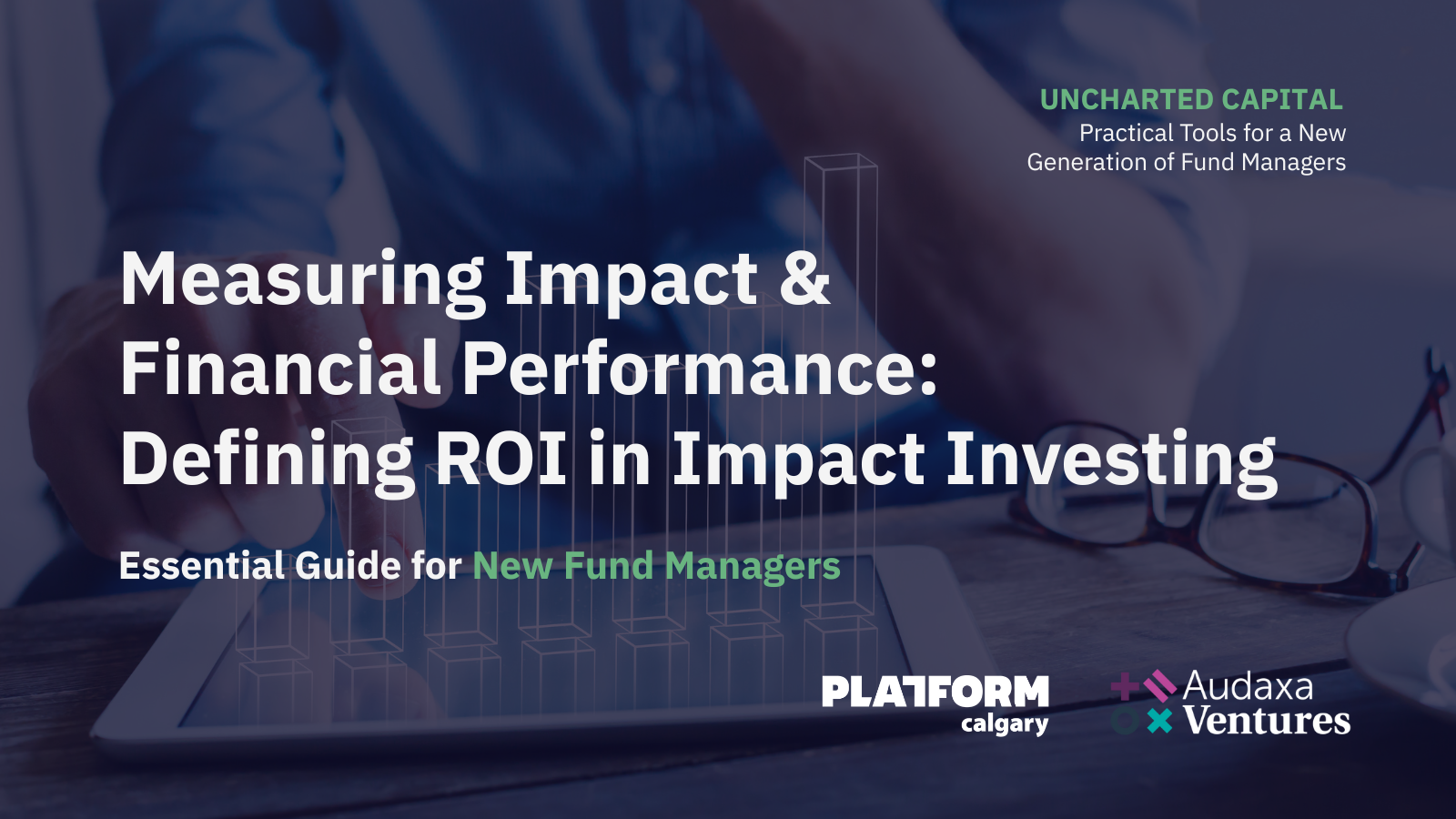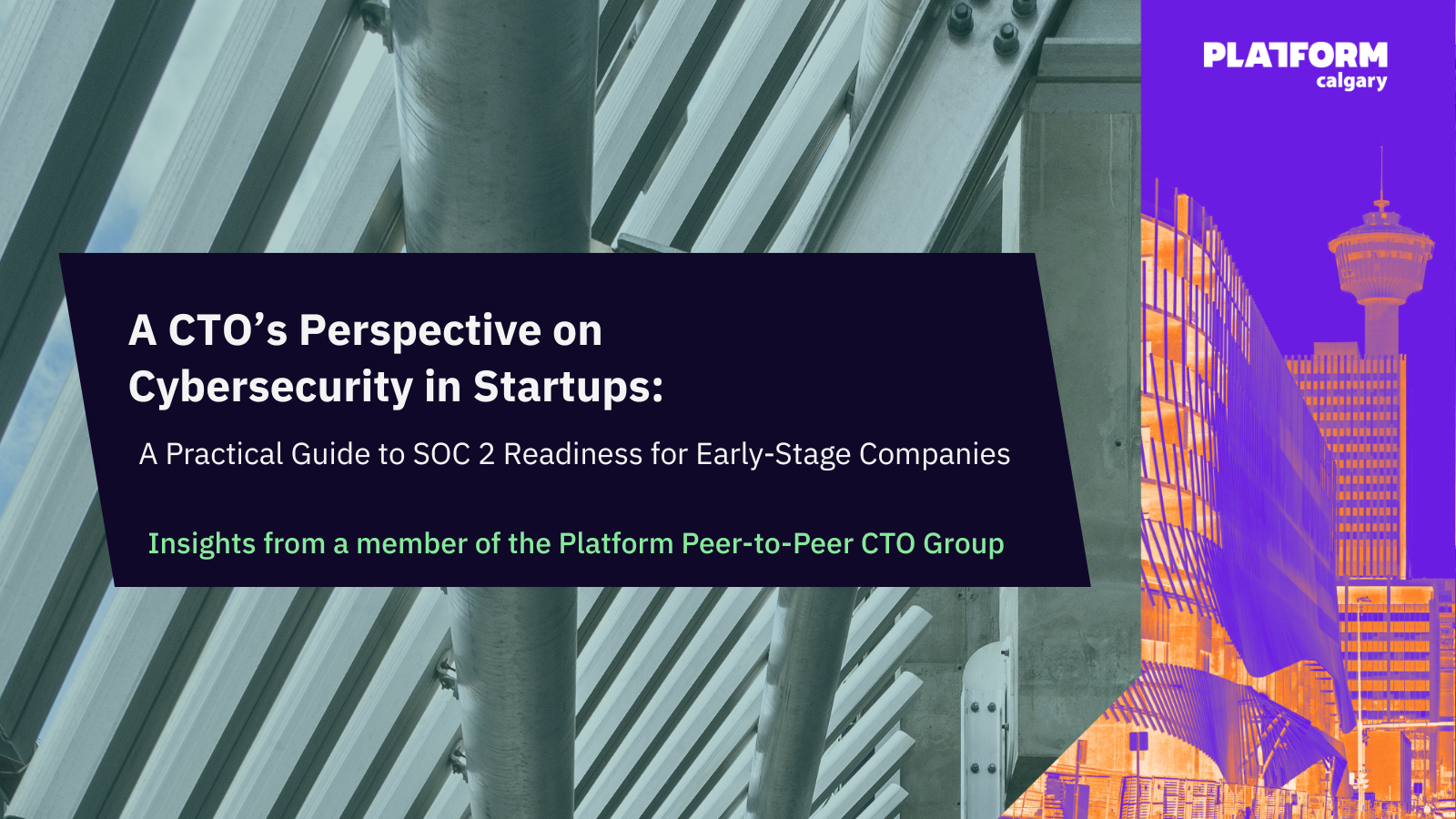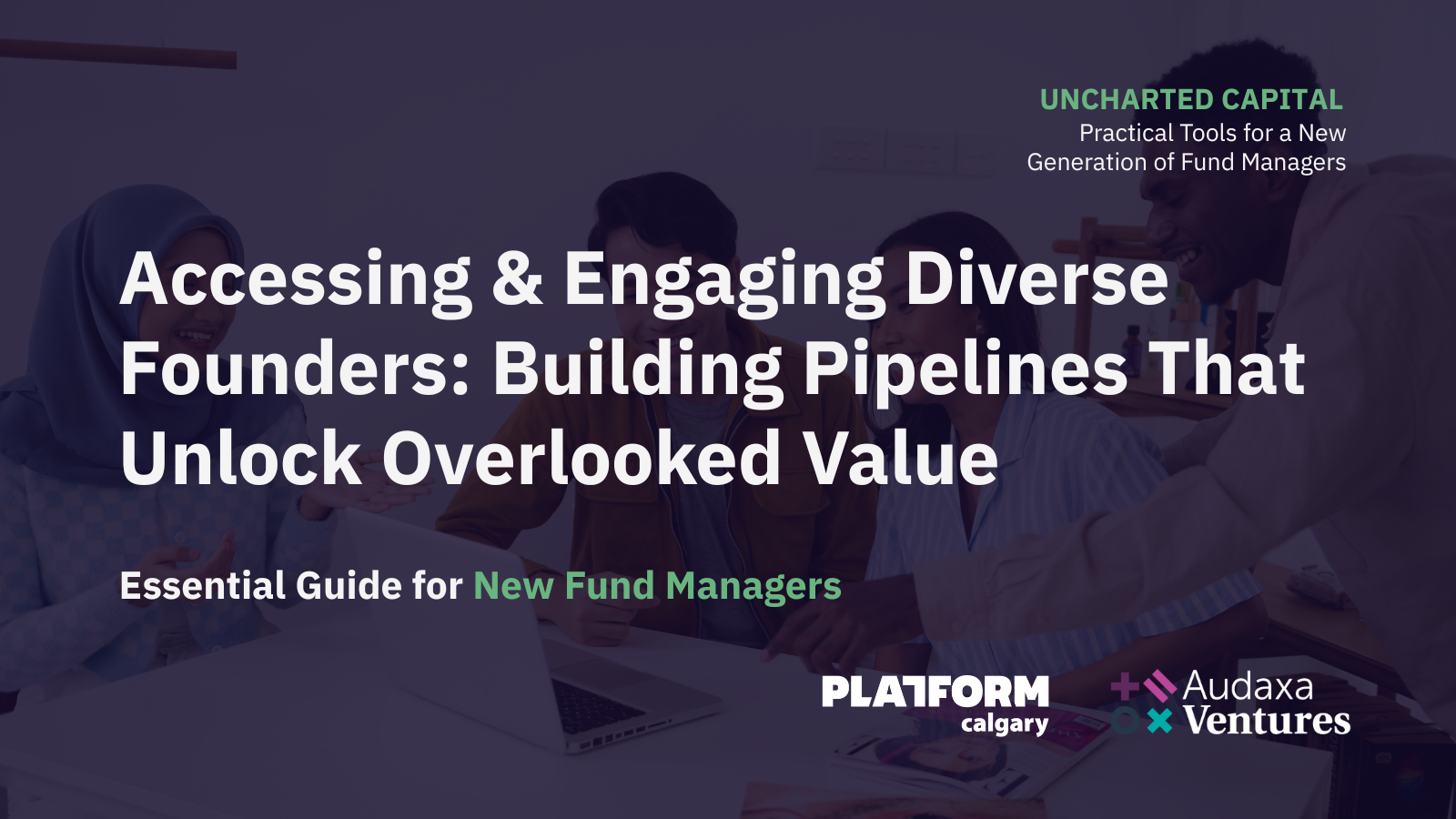Measuring Impact & Financial Performance: Defining ROI in Impact Investing

Platform Calgary is a non-profit, member based organization. Our mandate is to bring together the resources of Calgary's tech ecosystem to help startups launch and grow at every step of their journey, from ideation through to scale.
More about Platform CalgaryMeasuring Performance: Defining ROI in Impact Investing
Learn how emerging fund managers can define ROI in impact investing by connecting thesis, measurement, and financial returns—with lessons from funds in Canada and abroad.
By Raissa Espiritu & Hilary Kilgour, Audaxa Ventures in Collaboration with The National Bank Investor Hub at Platform Calgary
Preface
This is the fourth chapter in the Uncharted Capital series—a national collaboration between Audaxa Ventures and Platform Calgary. Our goal is to provide emerging fund managers with practical tools, grounded insights, and real-world case studies on how to build funds that balance financial and impact performance.
In our first piece, we explored how to design a differentiated thesis. In the second, we unpacked portfolio construction and capital deployment. In the third, we examined how to access and engage diverse founders.
Here, we take on one of the most debated topics in impact investing for both fund managers and LPs: how do you measure impact outcomes and financial performance side by side, and what does ROI look like in investing?
Why Measurement Matters
For emerging fund managers, measurement is credibility. It demonstrates that your thesis isn’t just words on a deck but can be validated through both financial and impact data.
In venture, performance is the language of credibility. For emerging fund managers, demonstrating performance—through warehouse deals, early investments, and exit potential—is essential for building track record and raising subsequent funds.
For LPs, family offices, and foundations shifting into impact investing, measurement is reassurance. It ensures that capital is not only generating returns, but also delivering clear, verifiable outcomes that align with mandate and mission.
As the Global Impact Investing Network (GIIN) reminds us:
“Impact investing is about intentionally placing capital to generate positive, measurable impact alongside financial returns.”
The dual promise - financial and impact - is what makes this work different from traditional venture capital investing. It must capture both:
- Financial returns: distributions, DPI, MOIC, and secondaries in a capital-constrained environment.
- Impact returns: evidence of real-world change - whether improved health outcomes, reduced emissions, or expanded access to capital.
The challenge - and opportunity - for emerging managers is to show LPs that both can and must coexist.
Myths vs. Realities: Measuring Impact & Financial Performance
Myth 1: “Impact can’t be measured consistently.”
- Reality: Impact is complex, but it can be measured with discipline and comparability. Frameworks like IRIS+, the Impact Frontiers’ Five Dimensions of Health, and Raven’s RIM Framework provide consistency while allowing for cultural context. Tools like SVX’s blended finance work in Latin America and Ada Ventures’ Inclusive Alpha show how consistency and nuance can co-exist. Measurement is not about perfection - it’s about being transparent, comparable, and improving over time.
Myth 2: “Measuring impact distracts from financial performance.”
- Reality: Data - and practice - prove otherwise.
Active Impact Investments publishes an integrated report quantifying both financial and environmental outcomes - GHG reductions, water savings, and waste diversion - reported alongside IRR and MOIC.
Leapfrog Investments has delivered top-quartile private equity returns while serving more than 350 million underserved consumers with health and financial products.
Far from distracting, impact diligence sharpens decision-making by surfacing risks earlier and identifying hidden opportunities.
- Counter: LPs still prioritize DPI, IRR, and multiples. But when integrated well, impact becomes a performance enhancer—de-risking portfolios, building customer loyalty, and strengthening resilience.
Myth 3: “Outcomes are harder to track than financial returns—so they don’t matter.”
- Reality: Yes, financial returns are easier to quantify—but that doesn’t mean outcomes are optional. Outcomes are harder to measure, but they are increasingly non-negotiable.
Take BKR Capital, Canada’s first Black-led VC fund. They don’t just track portfolio growth - they track how many Black founders secure Series A follow-on rounds, how their businesses create jobs in underserved communities, and how capital flows shift when representation changes at the GP level. For them, outcomes aren’t soft - they’re evidence of market transformation. Outcomes, when tracked with intent, often become leading indicators of long-term financial returns.
- Counter: Outcomes provide the why behind the numbers. LPs and founders increasingly expect both: traditional performance metrics and impact outcomes that prove companies are delivering more than financial returns. When integrated well, outcomes become a leading indicator of financial success.
Outcomes and returns are two sides of the same coin, and both must be tracked to create lasting value. When impact is measured with rigour, it strengthens, not competes with financial performance.
Impact as Strategy, Not Sideshow
Impact has been treated as a parallel track in venture—something reported after the fact, rather than embedded in investment decisions. Our learning from ImpactVC (currently partnered with both Realize and CIVIC) underscores that impact is a source of value, not a concession.
Impact companies often outperform because they:
- Anticipate regulatory shifts
- Attract purpose-driven talent
- Win customers faster
As IRIS+ emphasizes:
“Impact should not be a parallel track. It must be embedded into investment selection, monitoring, and reporting.”
This mindset shifts impact from extra to integral, aligning capital deployment with both commercial and societal value.
Lessons from the Field: Emerging Practices
Through VC Lab and the ImpactVC course (with Realize and CIVIC), and from studying peers we respect, we’ve seen consistent lessons that are shaping our own approach at Audaxa:
- Track record signals trust: Even without full exits, warehouse deals and early impact-aligned investments demonstrate credibility. With exits less common in the current VC market, LPs are scrutinizing secondaries and DPI more closely—emerging managers need to build realistic pathways to liquidity (CVCA)
- Impact diligence sharpens performance: Funds start with an impact screen before financial diligence. This approach surfaces capital efficiency, resilience, and founder discipline early—qualities that reduce surprises later
- Transparency on risk matters: Frameworks like ILPA’s DDQ and the Common Impact Data Standards (CIDS) help managers communicate risk in the same language as financial diligence, making impact more credible to LPs.
- Inclusivity drives returns: Internationally, Ada Ventures (UK) coined Inclusive Alpha®, embedding inclusivity into sourcing, diligence, and support. Co-Founder Check Warner explains: “Inclusive Alpha is about proving that inclusivity drives superior returns. It’s not a tradeoff—it’s a strategy for performance.”
- Impact and financial risk are intertwined: The best funds assess both together. Active Impact Investments quantifies climate metrics (carbon reduced, water saved) alongside IRR, normalizing impact as part of financial performance.
- Cultural context matters: Raven Capital Partners designed the RIM Framework to align impact with reconciliation and Indigenous well-being. As Co-Founder Jeff Cyr puts it: “Business moves at the speed of trust. Our framework isn’t just about numbers—it’s about relationships, reciprocity, and advancing reconciliation.”
Together, these lessons underline a critical shift: measurement isn’t an afterthought. It’s culture, strategy, and decision-making.
And while it can feel daunting, it’s important for emerging fund managers to know that:
- The tools already exist (ILPA DDQ, Canadian National Standard, IRIS+, SDGs, portfolio metrics).
- The playbook is evolving through peer sharing, courses, and peers who are willing to share.
- The opportunity is clear: funds that can prove ROI across both dimensions will earn trust faster, differentiate themselves, and unlock more capital.
A Framework for Measuring ROI + Impact
(with integrated and downloadable check-list at the end of the blog)
- Capital & Intent – Fund thesis, ILPA DDQ alignment, impact manual.
- Activities – Investment decisions, portfolio engagement, founder alignment.
- Outputs – Jobs created, emissions reduced, patients reached.
- Outcomes – System-level shifts (equity, resilience, health) - often tied to SDGs.
- Returns – DPI, MOIC + measurable progress toward impact goals.
As the Common Impact Data Standards (CIDS) note: “What gets measured gets managed—clear ROI metrics are essential for impact funds to scale credibility with mainstream LPs.”
CIDS also underpin ESDC’s Social Innovation & Social Finance Strategy, which funds impact managers via Boann, Realize, and CAP Finance—with DEI requirements (35% to equity-seeking groups; 15% gender-lens).
And as the SDGs remind us:
“Sustainable progress requires continuous learning—impact data should be a feedback loop, not a checkbox.”
Closing Reflection
For emerging managers, measuring impact alongside financial performance isn’t optional—it’s the edge.
Canada is still early, but bright spots include:
- Amplify Capital – impact-first diligence.
- Active Impact Investments – integrated climate + IRR reporting.
- Raven Indigenous Capital Partners – reconciliation as ROI.
- BKR Capital – representation as market strategy.
- Leapfrog Investments – global proof that financial alpha + impact scale together.
The larger truth is clear: Impact is performance. Measurement is not only possible but profitable.
Funds that can measure, communicate, and deliver on this dual ROI with the same rigor as financials will differentiate, unlock capital faster, and help redefine success in venture.
Additional Resources:
Case Studies: From Thesis to Metrics
In earlier chapters, we emphasized the importance of a clear thesis and disciplined portfolio design. Measurement is the connective tissue that makes both real.
Examples in practice:
Canada:
- Amplify Capital (Canada)
What they measure: Amplify begins with an impact screen before any formal diligence, ensuring only companies with clear, intentional impact move forward. Their portfolio spans climate, health, and the future of work, with companies like Inkblot (mental health) and Lucid (energy efficiency). As you’ll see in their 2024 Impact Report, they focus on delivered impact vs. projected outcomes—tracking metrics like tonnes of CO₂ reduced, lives impacted, or verified improvements in health access. (https://amplifycapital.ca/impact/)
“We start with impact because it tells us whether the company belongs in our portfolio. If the impact isn’t there, we don’t move forward to the rest of due diligence.” – Kathryn Wortsman, Managing Partner, Amplify Capital (Impact Report 2022)
- Active Impact Investments (Canada)
What they measure: Active Impact quantifies portfolio-wide outcomes—like GHG reductions, waste diversion, and water saved—and reports them alongside financial performance. Their latest integrated report - 2024 Climate Impact Report - frames environmental metrics as co-benefits of portfolio growth, directly linking unit economics to measurable climate outcomes. Given their thesis is to empower the most capable operators with sales and hiring expertise to aggressively scale, you see this show up in performance and talent goals. (https://www.activeimpactinvestments.com/thesis)
“Our job is to make carbon, waste, and water outcomes as tangible to investors as IRR. That’s how you normalize impact as part of financial performance.” – Mike Winterfield, Founder, Active Impact Investments (Impact Report 2023)
- Raven Indigenous Capital Partners (Canada)
What they measure: Raven developed the Raven Impact Measurement (RIM) Framework—a decolonized, culturally grounded approach, which integrates Indigenous values into ROI and ensures every investment contributes to the well-being of Native American and Indigenous Peoples. Guided by UNDRIP, their approach blends Indigenous and Western knowledge, outcomes include wealth creation, environmental stewardship, and cultural resilience. Their outcomes include wealth creation, economic reconciliation, environmental stewardship, and community benefit. Portfolio companies like Cheekbone Beauty and Animikii demonstrate ROI not just in revenue growth, but in culturally grounded community benefit that emphasizes that impact is diverse and personal, taking a listening, relational stance with. (https://ravencapitalpartners.com/approach/impact)
“Business moves at the speed of trust. Our framework isn’t just about numbers—it’s about relationships, reciprocity, and advancing reconciliation.” – Jeff Cyr, Co-Founder & Managing Partner, Raven Indigenous Capital Partners (2023 Impact Report)
- SVX (Latin America & Canada)
What they measure: Through its work in Mexico, Colombia, and Peru, SVX has helped design blended finance vehicles and impact funds that integrate SDG-aligned outcomes directly into investment processes. Their approach combines capacity building, impact due diligence, and investor education to ensure local fund managers can both attract international capital and report impact credibly. (https://svx.ca)
“When investors see impact data embedded in due diligence—not just after the deal—they understand that social and financial returns are inseparable.” – Adam Spence, CEO, SVX
Global:
- Ada Ventures (UK/Europe)
What they measure: Ada coined Inclusive Alpha®, embedding inclusivity into team structure, sourcing, and founder support. They measure ROI by tracking venture returns, portfolio inclusion surveys, founder well-being (e.g., childcare and mental health supports), and community representation. For example, 32% of investments in Fund I came through their scout program, proving that overlooked networks generate deal flow at competitive valuations. (https://www.adaventures.com/)
“Inclusive Alpha is about proving that inclusivity drives superior returns. It’s not a tradeoff—it’s a strategy for performance.” – Check Warner, Co-Founder, Ada Ventures (Inclusive Alpha Report 2023)
- Bridges Fund Management (UK/Global)
What they measure: Bridges uses a scorecard approach across financial conviction and impact potential. They track outcomes like job creation, community health, and sustainability practices, reporting in plain language accessible to both financial and non-financial LPs. (https://www.bridgesfundmanagement.com/)
“Impact is not an add-on—it’s part of how value gets created. That’s why we integrate it directly into our investment process and reporting.” – Michele Giddens, Co-Founder, Bridges Fund Management
- Leapfrog Investments (Global South)
What they measure: Leapfrog pioneered profit with purpose, reporting on financial returns and social reach (e.g., how many underserved people gained access to insurance or health products). Their integrated reports show top-quartile private equity returns while serving over 350 million low-income consumers.(https://leapfroginvest.com/)
“You don’t need to choose between profit and purpose. Our funds demonstrate you can deliver both at scale.” – Andy Kuper, Founder, Leapfrog Investments (Integrated Report 2022)
- Wagestream (UK) - example of portfolio company in Fintech
What they measure: A B2B2C financial well-being platform, Wagestream integrates impact measurement into product design. Metrics include reducing the “poverty premium” for workers, financial stress reduction, and employer retention. Their Articles of Incorporation explicitly embed impact goals, making impact + growth inseparable from the start. (https://wagestream.com/hubfs/22239477/Wagestream-Impact-Framework-UK.pdf)
“We don’t see a separation between our commercial growth and our impact—it’s the same story, the same value.” – Peter Briffett, CEO, Wagestream (Impact Report 2022)
Impact ROI Checklist for Emerging Managers
About Platform Calgary and the National Bank Investor Hub
Platform Calgary is a non-profit, community based organization with a mandate to bring together the resources of Calgary's tech ecosystem to help startups launch and grow at every step of their journey, from ideation to scale. The National Bank Investor Hub at Platform Calgary is a dedicated space designed to bridge the gap between investors and Calgary’s high-potential startups, accelerating growth and innovation. Through this strategic initiative, we foster faster connections between investors, founders, and capital, driving Calgary’s tech ecosystem forward.
About Audaxa Ventures
Audaxa Ventures is a women-led venture capital fund backing the most promising technology solutions at the intersection of climate and health.
We prioritize investments that not only improve the world and our communities but also provide our portfolio companies with the market access needed to expand their ventures and foster growth. We focus on women and non-binary founders who bring lived experience, diversity of thought, and bold approaches to solving some of society’s most urgent challenges. With a commitment of impact-driven capital, we prioritize return on impact alongside financial performance — supporting founders who are building companies that deliver measurable outcomes for people and the planet.
Published on
September 16, 2025
Tags
Explore more posts

For Ecosystem Builders
Maximizing SR&ED for AI Innovation: A Calgary Tech Leader's Guide to Claiming What You've Earned
As AI companies in Calgary push the boundaries of machine learning, computer vision, and intelligent automation, many are unknowingly leaving significant government funding on the table. The Scientific Research and Experimental Development (SR&ED) program offers substantial tax credits for qualifying R&D activities – but AI innovation presents unique opportunities and challenges that require strategic navigation.

For Startups
A CTO’s Perspective on Cybersecurity in Startups: A Practical Guide to SOC 2 Readiness for Early-Stage Companies
In today’s digital age, cybersecurity has become a cornerstone of business success. Organizations with established security processes often require their vendors to demonstrate a formal security posture as part of their due diligence. This process can be daunting for startups, as it involves providing evidence of security measures, processes, and continuous evaluation.







